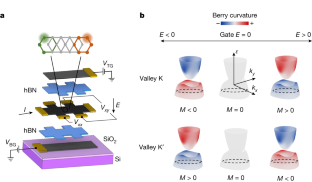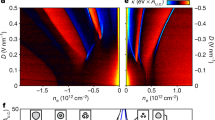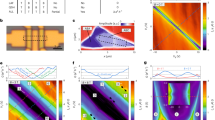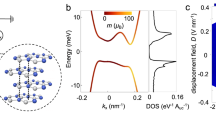Abstract
Ferroic orders describe spontaneous polarization of spin, charge and lattice degrees of freedom in materials. Materials exhibiting multiple ferroic orders, known as multiferroics, have important parts in multifunctional electrical and magnetic device applications1,2,3,4. Two-dimensional materials with honeycomb lattices offer opportunities to engineer unconventional multiferroicity, in which the ferroic orders are driven purely by the orbital degrees of freedom and not by electron spin. These include ferro-valleytricity corresponding to the electron valley5 and ferro-orbital-magnetism6 supported by quantum geometric effects. These orbital multiferroics could offer strong valley–magnetic couplings and large responses to external fields—enabling device applications such as multiple-state memory elements and electric control of the valley and magnetic states. Here we report orbital multiferroicity in pentalayer rhombohedral graphene using low-temperature magneto-transport measurements. We observed anomalous Hall signals Rxy with an exceptionally large Hall angle (tanΘH > 0.6) and orbital magnetic hysteresis at hole doping. There are four such states with different valley polarizations and orbital magnetizations, forming a valley–magnetic quartet. By sweeping the gate electric field E, we observed a butterfly-shaped hysteresis of Rxy connecting the quartet. This hysteresis indicates a ferro-valleytronic order that couples to the composite field E · B (where B is the magnetic field), but not to the individual fields. Tuning E would switch each ferroic order independently and achieve non-volatile switching of them together. Our observations demonstrate a previously unknown type of multiferroics and point to electrically tunable ultralow-power valleytronic and magnetic devices.
This is a preview of subscription content, access via your institution
Access options
Access Nature and 54 other Nature Portfolio journals
Get Nature+, our best-value online-access subscription
$29.99 / 30 days
cancel any time
Subscribe to this journal
Receive 51 print issues and online access
$199.00 per year
only $3.90 per issue
Buy this article
- Purchase on Springer Link
- Instant access to full article PDF
Prices may be subject to local taxes which are calculated during checkout





Similar content being viewed by others
Data availability
The data shown in the main figures are available at Harvard Dataverse (https://doi.org/10.7910/DVN/Z2HKPY). Other data that support the findings of this study are available from the corresponding author upon reasonable request.
References
Eerenstein, W., Mathur, N. D. & Scott, J. F. Multiferroic and magnetoelectric materials. Nature 442, 759–765 (2006).
Fiebig, M., Lottermoser, T., Meier, D. & Trassin, M. The evolution of multiferroics. Nat. Rev. Mater. 1, 16046 (2016).
Spaldin, N. A., Cheong, S. W. & Ramesh, R. Multiferroics: past, present, and future. Phys. Today 63, 38–43 (2010).
Jin, W. et al. Observation of a ferro-rotational order coupled with second-order nonlinear optical fields. Nat. Phys. 16, 42–46 (2019).
Xu, X., Yao, W., Xiao, D. & Heinz, T. F. Spin and pseudospins in layered transition metal dichalcogenides. Nat. Phys. 10, 343–350 (2014).
Xiao, D., Chang, M.-C. & Niu, Q. Berry phase effects on electronic properties. Rev. Mod. Phys. 82, 1959–2007 (2010).
Mak, K. F., McGill, K. L., Park, J. & McEuen, P. L. The valley Hall effect in MoS2 transistors. Science 344, 1489–1492 (2014).
Ju, L. et al. Topological valley transport at bilayer graphene domain walls. Nature 520, 650–655 (2015).
Yin, J. et al. Tunable and giant valley-selective Hall effect in gapped bilayer graphene. Science 375, 1398–1402 (2022).
Xiao, D., Yao, W. & Niu, Q. Valley-contrasting physics in graphene: magnetic moment and topological transport. Phys. Rev. Lett. 99, 236809 (2007).
Ju, L. et al. Tunable excitons in bilayer graphene. Science 358, 907–910 (2017).
Tong, W.-Y., Gong, S.-J., Wan, X. & Duan, C.-G. Concepts of ferrovalley material and anomalous valley Hall effect. Nat. Commun. 7, 13612 (2016).
Abouelkomsan, A., Bergholtz, E. J. & Chatterjee, S. Multiferroicity and topology in twisted transition metal dichalcogenides. Preprint at https://arxiv.org/abs/2210.14918 (2022).
Wang, T., Vila, M., Zaletel, M. P. & Chatterjee, S. Electrical control of spin and valley in spin-orbit coupled graphene multilayers. Preprint at https://arxiv.org/abs/2303.04855 (2023).
Zhou, H. et al. Half- and quarter-metals in rhombohedral trilayer graphene. Nature 598, 429–433 (2021).
Zhou, H. et al. Isospin magnetism and spin-polarized superconductivity in Bernal bilayer graphene. Science 375, 774–778 (2022).
de la Barrera, S. C. et al. Cascade of isospin phase transitions in Bernal-stacked bilayer graphene at zero magnetic field. Nat. Phys. 18, 771–775 (2022).
Shi, Y. et al. Electronic phase separation in multilayer rhombohedral graphite. Nature 584, 210–214 (2020).
Chen, G. et al. Tunable correlated Chern insulator and ferromagnetism in a moiré superlattice. Nature 579, 56–61 (2020).
Sharpe, A. L. et al. Emergent ferromagnetism near three-quarters filling in twisted bilayer graphene. Science 365, 605–608 (2019).
Serlin, M. et al. Intrinsic quantized anomalous Hall effect in a moiré heterostructure. Science 367, 900–903 (2020).
Polshyn, H. et al. Electrical switching of magnetic order in an orbital Chern insulator. Nature 588, 66–70 (2020).
Chen, S. et al. Electrically tunable correlated and topological states in twisted monolayer–bilayer graphene. Nat. Phys. 17, 374–380 (2020).
Li, T. et al. Quantum anomalous Hall effect from intertwined moiré bands. Nature 600, 641–646 (2021).
Zhu, J., Su, J. J. & MacDonald, A. H. Voltage-controlled magnetic reversal in orbital Chern insulators. Phys. Rev. Lett. 125, 227702 (2020).
Yang, J. et al. Spectroscopy signatures of electron correlations in a trilayer graphene/hBN moiré superlattice. Science 375, 1295–1299 (2022).
Min, H. & MacDonald, A. H. Electronic structure of multilayer graphene. Prog. Theor. Phys. Suppl. 176, 227–252 (2008).
Zhang, F., Jung, J., Fiete, G. A., Niu, Q. & MacDonald, A. H. Spontaneous quantum Hall states in chirally stacked few-layer graphene systems. Phys. Rev. Lett. 106, 156801 (2011).
Koshino, M. & McCann, E. Trigonal warping and Berry’s phase Nπ in ABC-stacked multilayer graphene. Phys. Rev. B 80, 165409 (2009).
Weitz, R. T., Allen, M. T., Feldman, B. E., Martin, J. & Yacoby, A. Broken-symmetry states in doubly gated suspended bilayer graphene. Science 330, 812–816 (2010).
Velasco, J.Jr et al. Transport spectroscopy of symmetry-broken insulating states in bilayer graphene. Nat. Nanotechnol. 7, 156–160 (2012).
Nagaosa, N., Sinova, J., Onoda, S., MacDonald, A. H. & Ong, N. P. Anomalous Hall effect. Rev. Mod. Phys. 82, 1539–1592 (2010).
Liu, E. et al. Giant anomalous Hall effect in a ferromagnetic kagome-lattice semimetal. Nat. Phys. 14, 1125–1131 (2018).
Matsukura, F., Tokura, Y. & Ohno, H. Control of magnetism by electric fields. Nat. Nanotechnol. 10, 209–220 (2015).
Dong, Z., Davydova, M., Ogunnaike, O. & Levitov, L. Isospin- and momentum-polarized orders in bilayer graphene. Phys. Rev. B 107, 075108 (2021).
Szabó, A. L. & Roy, B. Competing orders and cascade of degeneracy lifting in doped Bernal bilayer graphene. Phys. Rev. B 105, L201107 (2022).
Huang, C. et al. Spin and orbital metallic magnetism in rhombohedral trilayer graphene. Phys. Rev. B 107, L121405 (2023).
Gnewuch, S. & Rodriguez, E. E. The fourth ferroic order: current status on ferrotoroidic materials. J. Solid State Chem. 271, 175–190 (2019).
Fan, Y. et al. Magnetization switching through giant spin–orbit torque in a magnetically doped topological insulator heterostructure. Nat. Mater. 13, 699–704 (2014).
He, W.-Y., Goldhaber-Gordon, D. & Law, K. T. Giant orbital magnetoelectric effect and current-induced magnetization switching in twisted bilayer graphene. Nat. Commun. 11, 1650 (2020).
Li, H. et al. Electrode-free anodic oxidation nanolithography of low-dimensional materials. Nano Lett. 18, 8011–8015 (2018).
Han, T. et al. Correlated insulator and Chern insulators in pentalayer rhombohedral stacked graphene. Preprint at https://arxiv.org/abs/2305.03151 (2023).
Zhang, F., Sahu, B., Min, H. & MacDonald, A. H. Band structure of ABC-stacked graphene trilayers. Phys. Rev. B 82, 035409 (2010).
Tian, Y., Ye, L. & Jin, X. Proper scaling of the anomalous Hall effect. Phys. Rev. Lett. 103, 087206 (2009).
Borders, W. A. et al. Integer factorization using stochastic magnetic tunnel junctions. Nature 573, 390–393 (2019).
Mizrahi, A. et al. Neural-like computing with populations of superparamagnetic basis functions. Nat. Commun. 9, 1533 (2018).
Fei, Z. et al. Ferroelectric switching of a two-dimensional metal. Nature 560, 336–339 (2018).
de la Barrera, S. C. et al. Direct measurement of ferroelectric polarization in a tunable semimetal. Nat. Commun. 12, 5298 (2021).
Hunt, B. M. et al. Direct measurement of discrete valley and orbital quantum numbers in bilayer graphene. Nat. Commun. 8, 948 (2017).
Acknowledgements
We acknowledge discussions with F. Zhang, J. Checkelsky, L. Levitov, Z. Dong, W. He, P. Yu, Y. Ba, F. Wang and L. Zhao. We acknowledge Y. Yao for his help in sample fabrication. L.J. acknowledges support from a Sloan Fellowship. Work by Tonghang Han was supported by the National Science Foundation (NSF) (grant no. DMR-2225925). The device fabrication of this work was supported by the STC Center for Integrated Quantum Materials (NSF grant no. DMR-1231319) and was carried out at the Harvard Center for Nanoscale Systems and MIT.nano. Part of the device fabrication was supported by USD (R&E) under contract no. FA8702-15-D-0001. K.W. and T.T. acknowledge support from the JSPS KAKENHI (grant nos 20H00354, 21H05233 and 23H02052) and the World Premier International Research Center Initiative, MEXT, Japan. L.F. was supported by the STC Center for Integrated Quantum Materials under NSF award no. DMR-1231319. H.P. acknowledges support from NSF (grant no. PHY-1506284) and AFOSR (grant no. FA9550-21-1-0216). A portion of this work was performed at the National High Magnetic Field Laboratory, which is supported by the NSF Cooperative Agreement no. DMR-2128556* and the State of Florida.
Author information
Authors and Affiliations
Contributions
Tonghang Han, Z.L., G.S., J.S. and J.W. performed the d.c. magneto-transport measurement. Tonghang Han and Tinayi Han fabricated the devices. K.W. and T.T. grew hBN single crystals. Tonghang Han performed the tight-binding calculations. H.P. and L.F. contributed to the data analysis. L.J. supervised the project. All authors discussed the results and wrote the paper.
Corresponding author
Ethics declarations
Competing interests
The authors declare no competing interests.
Peer review
Peer review information
Nature thanks Jianpeng Liu, Jianming Lu and the other, anonymous, reviewer(s) for their contribution to the peer review of this work. Peer reviewer reports are available.
Additional information
Publisher’s note Springer Nature remains neutral with regard to jurisdictional claims in published maps and institutional affiliations.
Extended data figures and tables
Extended Data Fig. 1 Raman characterization and phase diagram of rhombohedral penta layer graphene.
a, b, 2D Raman peak of Bernal (black) and rhombohedral (red) stacked pentalayer graphene before (a) and after (b) hBN encapsulation. The rhombohedral stacking is preserved after hBN encapsulation. c, d, Color plots of four-probe resistance Rxx as a function of carrier density n and displacement field E for the hole doping side (c) and electron doping side (d) measured at B = 0 and a temperature of 100 mK. Colored dots label different phases including band insulator (BI), correlated insulator (CI), spin-polarized half metal (SPHM), isospin-polarized quarter metal (IPQM) and unpolarized metal (UP). The red star labels the valley polarized half metal (VPHM), which is the focus of the maintext. The details of IPQM and SPHM states can be found in ref. 42.
Extended Data Fig. 2 Isospin degeneracy inferred from Landau level spacing.
Color plots of four-probe resistance Rxx as a function of carrier density n and displacement field E for the small hole doping VPHM region (a) and large hole doping UP region (b) measured at B = 2 T and a temperature of 300 mK. The straight features correspond to Landau levels and the spacing indicates the degeneracy d of the band. With d = 4, all four isospin flavors are present at the Fermi surfaces. With d = 2, two out of four isospin flavors have Fermi surfaces (the so-called half-metal).
Extended Data Fig. 3 Single particle band structure and density of states of rhombohedral stacked multilayer graphene.
a–d, Tight-binding calculation of single particle band structure and density of states (DOS) for rhombohedral stacked multilayer graphene (layer number N = 2 (a), 3 (b), 4 (c), 5 (d)). Due to the remote hopping, the band structure deviates from E ≈ kN at low energy. The rhombohedral pentalayer graphene has the flattest band among all layer numbers.
Extended Data Fig. 4 Hall conductivity calculation.
a, Tight-binding calculation of band structure for rhombohedral pentalayer graphene near the K point with an interlayer potential 2 E0 = 0 meV (black) and 16 meV (grey). Inset shows an iso-energy contour at –5 meV and the black and white circles represent Dirac points with Berry phase π and –π, which are also labeled by the black and white arrows in the band structure. b, Calculation of Hall conductivity \({\sigma }^{{xy}}\) with respect to the doping density ne and interlayer potential E0 for a single valley. The hot spots at around −1.2 and 0.4*1012 cm−2 correspond to the four Dirac points at smaller k and the three Dirac points at larger k respectively. c, The same plot as b with the contribution from the other valley at zero density (same position and opposite value to the dashed line in b). d, Colored-coded band structure in the K valley, showing the Berry curvature distribution at varied gate electric field Es. The iso-energy contour at Fermi level EF is labeled by the dashed circle. \({\sigma }^{{xy}}\) can be calculated by integrating the Berry curvature below EF. At E = 0 mV/nm, Berry curvature is zero everywhere except for at the Dirac points, and \({\sigma }^{{xy}}\) is zero. As E increases, Berry curvature hot spots emerge near the Dirac points and spread out. Consequently, there is more Berry curvature on states below EF and \({\sigma }^{{xy}}\) increases with E. e, Linecuts in c from ne = 0 to −0.5*1012 cm−2 for a single spin copy. At a small interlayer potential E0, the Hall conductivity is roughly linear with E0. f, Measured \({\sigma }^{{xy}}\) at 20mT and 0.3 K. The linear E dependence of \({\sigma }^{{xy}}\) agrees with the calculation qualitatively. Measurements on the positive E side suffer from contact issue at low temperatures.
Extended Data Fig. 5 Magnetic hysteresis at 0.3 K and 2 K at different doping.
a, Color plots of four-probe resistance Rxy as a function of carrier density n and displacement field E for the small hole doping VPHM region at B = 0.5 T and T = 0.3 K. b & c, Rxy as the magnetic field B is scanned, showing clear hysteresis loops within the droplet region. Curves correspond to dots with the same color in a at E = 5 mV/nm and different ne at T = 0.3 K a and 2 K b, and are shifted vertically for clarity. Solid and dashed curves correspond to forward and backward scanning of the B field. At 2 K, the coercive field of magnetic hysteresis almost vanishes, consistent with the disappearance of the ferro-valleytronic order at 2 K.
Extended Data Fig. 6 Control valley with E∙B field.
a & b, Plots of valley polarization correspond to the Rxy plot in Figs. 3d and e with B > 0 (a) and B < 0 (b), featuring two hysteresis loops winding in opposite ways. However, if we plot the x-axis as the E ∙ B field, the two loops will collapse into one, which demonstrates that the conjugate field of the valley is E ∙ B. Blue (yellow) lines labels scanning to positive (negative) E direction. The arrows indicate the scanning direction.
Extended Data Fig. 7 Evolution of the ‘butterfly’ as a function of magnetic field and temperature at ne=−0.65*1012cm−2 and ne=−0.45*1012cm−2.
a & b. Rxy as E is scanned at different magnetic fields at ne = −0.65*1012 cm−2. d & e. Rxy as E is scanned at different temperatures at ne = −0.65*1012 cm−2 and B = 30 mT. e & f. Critical fields EB and ET from a–d. g. Effective g-factor of the averaged orbital magnetic moment as a function of E extracted from e & f. h–n. Same measurements and analysis as a–g at ne = −0.45*1012 cm−2.
Extended Data Fig. 8 Fluctuation of magnetization at zero magnetic field.
Rxy as a function of time, measured at ne = −0.7*1012cm−2, E = 4 mV/nm, B = 0 and T = 300 mK. Rxy flips sign frequently with time, indicating the fluctuation of the magnetization due to the finite size of the magnet. A small external B field (20mT) can stabilize the system without changing the ground state.
Extended Data Fig. 9 Hall resistance behaviors under different measuring conditions.
a & b, 2D color maps of Rxy in the droplet region corresponding to forward and backward scanning of E with a small negative magnetic field B = −20 mT. c & d, The same plot as in a and b but with scanning density ne at B = 20 mT. e & f, The same plot as in a and b but with scanning density ne with B = −20 mT. Rxy changes the sign as we scan E but stays the same sign as we scan ne. This is due to the fact that the magnetic moment for a given valley will reverse as we scan E but not ne. As we scan n, the system will choose to polarize to the valley with the magnetic moment parallel with external B. The random jumps near E = 0 when scanning ne is because the magnetic moment near E = 0 is very small and the coupling to the external B field is weak, so the system cannot decide which valley to choose.
Extended Data Fig. 10 Longitudinal resistance Rxx hysteresis.
a & b, The same plot as Fig. 3d & e. The arrow indicates the jump in Rxy where the valley switches. c & d, The same plot as in a & b for Rxx. The arrow indicates where Rxx jumps and it also coincides with where the Rxy jumps. e & f, Linecuts of Rxx and Rxy at ne = −0.67*1012cm−2 as indicated by the dashed line in a–d. g & h, The same plot as Fig. 4a & b. i & j, The same plot as in g & h for Rxx. The jumps in Rxx correspond to that in Rxy. k & l, Linecuts of Rxx and Rxy at B = −0.16 T as indicated by the dashed line in a–d. The jumps in Rxx indicate the valley-switching is a first-order process.
Extended Data Fig. 11 Ferro-valleytricity and ferroelectricity.
a. The opening of the band gap E0 by a gate electric field E is effectively inducing an electric dipole P0 which couples to E and lowers the energy of the occupied states. The Berry curvature and orbital magnetization in the K and K’ valleys are opposite. b. Given a non-zero E, the valence bands in the K and K’ valley experience further shift in a magnetic field B. The shift is proportional to the orbital magnetization of the occupied states. This shift in energy M·B = aE·B can be viewed as M·B = E·(aB) = E·P’, where is effectively an additional electric dipole P’. This latter part of electric dipole P’ matters for the valleytricity while the P0 does not. c. Ferro-electricity in the valley-polarized state at E = 0, |B | > 0. Upper panel: illustration of the valley polarization and imbalanced population of the zeroth Landau levels in K and K’ valley at a non-zero B. Lower panel: valley and sublattice and layer have a one-to-one-to-one correspondence in the zeroth Landau level of rhombohedral graphene. Thus a valley polarization at non-zero B implies layer polarization and an electric dipole at E = 0 mV/nm. In this picture, ferro-electricity should exist at E = 0 mV/nm and |B | > 0 mT.
Extended Data Fig. 12 Density and in-plane magnetic field scan at E=0.
a. Rxx versus forward and backward scanning of n. b. Rxx versus forward and backward scanning of B//.
Supplementary information
Rights and permissions
Springer Nature or its licensor (e.g. a society or other partner) holds exclusive rights to this article under a publishing agreement with the author(s) or other rightsholder(s); author self-archiving of the accepted manuscript version of this article is solely governed by the terms of such publishing agreement and applicable law.
About this article
Cite this article
Han, T., Lu, Z., Scuri, G. et al. Orbital multiferroicity in pentalayer rhombohedral graphene. Nature 623, 41–47 (2023). https://doi.org/10.1038/s41586-023-06572-w
Received:
Accepted:
Published:
Issue Date:
DOI: https://doi.org/10.1038/s41586-023-06572-w
This article is cited by
-
Fractional quantum anomalous Hall effect in multilayer graphene
Nature (2024)
-
Layer-polarized ferromagnetism in rhombohedral multilayer graphene
Nature Communications (2024)
-
Fractional quantum Hall effect at zero magnetic field observed in an unexpected material
Nature (2024)
Comments
By submitting a comment you agree to abide by our Terms and Community Guidelines. If you find something abusive or that does not comply with our terms or guidelines please flag it as inappropriate.



